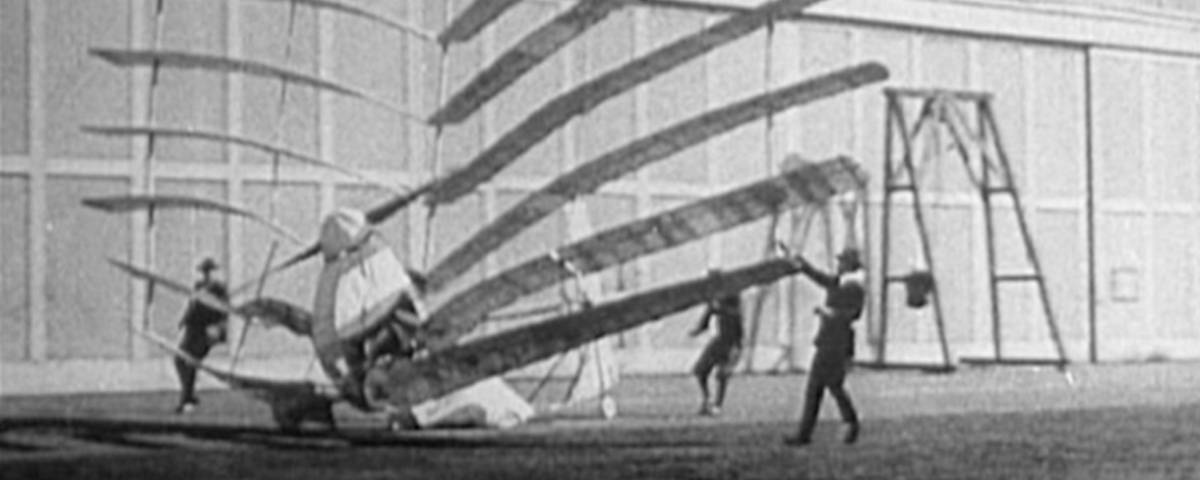The experimental Gerhardt Cycleplane made history in 1923, but today is best remembered as an iconic aviation failure.
Most everyone has seen the film clip of a multi-winged airplane trundling toward the camera, with a couple of men supporting its flimsy-looking wings until the towering contraption suddenly collapses in a heap. The footage has become symbolic of early aviation failures, endlessly played back as an example of the lengths to which some pioneers went in their efforts to achieve flight. Few are aware, however, that the flying machine featured in that comic clip was not the half-baked creation of a crackpot but an experimental human-powered airplane designed by the head of the Aeronautical Department at the University of Michigan. William Frederick Gerhardt built and flew his Cycleplane, as he called it, in 1923 at McCook Field in Dayton, Ohio, then the home of the U.S. Army Air Service Engineering Division’s aviation experimentation and flight-testing station.
Even after powered controlled flight became a reality early in the 20th century, a few aircraft designers still sought to emulate birds by achieving human-powered flight. But compared with other forms of propulsion, developing a flying machine powered solely by its pilot presents a daunting challenge. The average human can generate only about 1 hp, and sustain that for a limited amount of time, depending on how physically fit the person is. Thus a human-powered aircraft must be extremely lightweight but have wings that develop a great deal of lift.
Reducing structural weight invariably results in airplanes that are relatively flimsy. The human-powered British SUMPAC and Puffin of the 1960s, as well as the American Gossamer Condor and Gossamer Albatross, created by Paul McCready in the 1970s, managed to get airborne by means of state-of-the-art engineering, modern high-tech materials and, perhaps most important, the application of plenty of money.
The little-known Gerhardt Cycleplane of 1923 beat them all into the air. And yes, there is evidence that it actually flew. Records indicate that on several occasions it was towed aloft behind a car and released, then briefly maintained level flight. In one instance it also reportedly became airborne under its pilot’s power, albeit for a distance of only about 20 feet at an altitude of 2 feet—a modest accomplishment, to say the least, but sufficient for its creators to claim the distinction of building the first human-powered aircraft to fly.
The Cycleplane was the subject of an article in the October 1923 issue of Popular Science Monthly, accompanied by a photograph purportedly showing it airborne. It was also referenced in the February 21, 1924, issue of Flight magazine in an article by Mathew B. Sellers, “The Requirements of a Man-Propelled Airplane,” which mentioned “The recent success achieved by the Gerhardt ‘cycleplane’ in flying off the ground with a propeller actuated by foot power.”
Gerhardt created the Cycleplane as an experiment, to see if it would be possible for a human-powered airplane to attain level, stable flight. He and a few colleagues constructed it in a hangar at McCook Field during their spare time, while Gerhardt was attached to the Engineering Division.
The flying machine’s airframe consisted mainly of wood, covered with paper rather than fabric to save weight. The peculiar-looking arrangement of its seven narrow-chord wings was based on a design previously patented by Gerhardt and Isaac M. Laddon for a larger powered multiplane. They claimed their design would solve “problems of vision, performance, stability and controllability.” Since neither the text of the patent nor the appended design drawings indicate provision for either ailerons or wing-warping, it is unclear exactly how lateral control could have been achieved. And while the Cycleplane appears to have had a controllable rudder, surviving photos don’t show whether or not the horizontal tail surfaces were movable.
https://youtu.be/1FpezebG2zM
As a result of its seven-winged configuration, the Cycleplane was actually taller than it was long, about 19 feet high and 12 feet long. Its wingspan was approximately 40 feet, but the chord of each wing was only about 18 inches. The entire aircraft was said to weigh 95 pounds. The pilot sat in an open cockpit with his head just above the fuselage top, working pedals that drove a two-blade propeller. Photographs of the Cycleplane indicate it had a rather roughly finished appearance, not surprising since it was fabricated out of odds and ends.
For many years the sole legacy of Gerhardt’s Cycleplane has been that one sad bit of film that has amused audiences for generations. In retrospect, perhaps his invention should be remembered with more respect. After all, it can be seen as a precursor to more successful efforts, specifically those achieved by Southampton University and the Hatfield Man Powered Aircraft Club in Britain in the early 1960s, as well as by Paul MacCready’s AeroVironment in the United States during the 1970s. On November 9, 1961, at Lasham Airfield in Britain, Derek Piggott made the first officially recognized takeoff and landing of a human-powered aircraft. His longest flight in Southampton University’s Man Powered Aircraft stretched 650 meters, more than 100 times the distance of the Cycleplane’s alleged 1923 hop. But it would remain for MacCready’s Gossamer Condor to truly demonstrate controlled, human-powered flight on August 23, 1977, by completing a figure-eight course over a distance of 1.35 miles. Today that aircraft hangs above the main concourse at the National Air and Space Museum in Washington, D.C. Its sister aircraft, the Gossamer Albatross, which flew across the English Channel in 1979, is on display at the museum’s Udvar-Hazy Center near Dulles Airport.
This article originally appeared in the January 2017 issue of Aviation History Magazine. Subscribe today!

